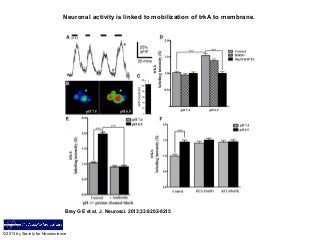
Phospho TrkA to Study Pain Sensing Neuronal Depolarization
- 1. Neuronal activity is linked to mobilization of trkA to membrane. Bray G E et al. J. Neurosci. 2013;33:8202-8215 ©2013 by Society for Neuroscience
Editor's Notes
- Neuronal activity is linked to mobilization of trkA to membrane. A , Acid-induced [Ca 2+ ]i increases in DRG cells. Typical sample trace exhibiting reversible repeatable Ca 2+ transients upon exposure of sensory neurons to a lowered pH of 6.5. The six-point asterisk in the trace refers to the pseudocolor image seen in B (pH 7.4) exhibiting baseline fluorescence. The five-point asterisk highlights a typical peak Ca 2+ response seen in the corresponding pseudocolor image seen in B (pH 6.5). C , Bar graph representing the mean Ca 2+ increase observed upon repeated exposure to a lowered pH of 6.5 ( n = 6 neurons; ±SEM). D , E , Summary bar graphs of data (normalized to pH 7.4 controls), depicting relative changes in the level of membrane-associated trkA expression in adult DRG neurons exposed to acidic (pH 6.5) or control (pH 7.4) media for 30 min in the presence or absence of Ca 2+ chelator BAPTA-AM (50 μm), DMSO, or the acid-sensing ion channel blocker amiloride (250 μm). Note: Blocking proton-sensitive channels or chelating Ca 2+ greatly attenuates the amount of trkA detected on the cell surface in response to acidosis when compared with pH 6.5 alone. F , Summary bar graphs from experiments (normalized to pH 7.4 controls), depicting relative changes in membrane-associated trkA expression in adult DRG neurons exposed for 30 min to acidic (pH 6.5) or control (pH 7.4) media for 30 min with or without KCl depolarization (15 mm or 45 mm) as indicated. Note: KCl-induced depolarization of neurons exposed to pH 7.4 results in mobilization of trkA to the membrane in a manner equivalent to that observed in response to a lowered pH of 6.5; but KCl does not induce further mobilization in neurons already exposed to pH 6.5. (one-way ANOVA with post hoc Tukey's; *** p < 0.001; n = 101–140 neurons analyzed per experimental condition).
